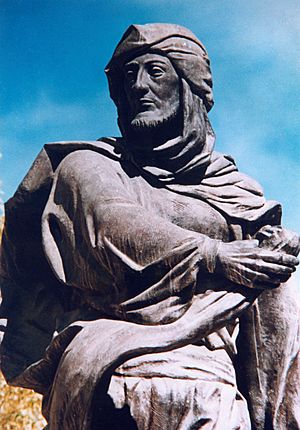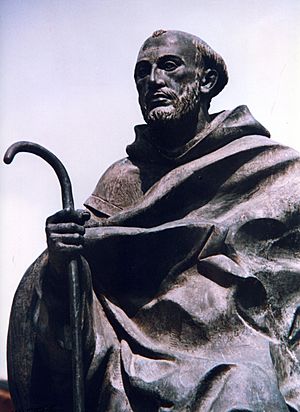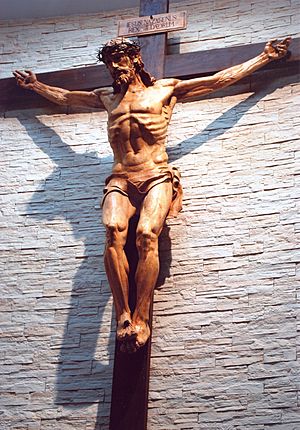Rafael Pi Belda facts for kids
Quick facts for kids
Rafael Pi Belda
|
|
|---|---|
| Born | January 25, 1929 |
| Died | April 3, 2012 (aged 83) |
| Nationality | Spanish |
| Known for | Sculpture |
Rafael Pi Belda (born January 25, 1929 – died April 3, 2012) was a talented sculptor from Spain. He learned about art in Valencia, studying under famous artists like Enrique Pérez Comendador and José Ortells López. His sculptures often showed real people and things, a style known as "figurative" art.
Contents
About Rafael Pi Belda
His Early Life
Rafael Pi Belda was born in Valencia, Spain, on January 25, 1929. He grew up in a family where his father fixed furniture. His mother also helped him discover his love for art. As a child, he lived in an old part of Valencia near the Cathedral. Many artists there made religious statues. Watching them work made him want to become a sculptor too.
How He Learned Art
When Rafael was sixteen, he started going to the workshops of sculptor Carmelo Vicent. There, he learned how to make models, carve, and create raised designs (reliefs). This training helped him get ready for the entrance exam to the Real Academia de Bellas Artes de San Carlos de Valencia, a famous art school.
From 1947 to 1952, he studied sculpture at this school. He learned from great teachers like Octavio Vicent, Carmelo Vicent, Enrique Giner, and Manuel Beltrán. In 1952, when he was 23, he received a special scholarship from the government of Valencia. This allowed him to continue his art studies in Madrid and Italy.
His Career as a Sculptor
In 1983, Rafael Pi Belda began creating very large bronze statues. One of his first big works was Al moro y al cristiano. This sculpture is located in Caravaca de la Cruz in Murcia, Spain.
Until 1994, he worked as a secondary school teacher while also making sculptures in his workshop. After 1997, he focused only on his sculpture work, creating many beautiful pieces.
What Made His Art Special
Rafael Pi Belda's sculptures are known for their strong technique and honest style. He was an independent artist who developed his own way of working. His art is often described as "Mediterranean impressionism." This means his sculptures capture the feeling and light of the Mediterranean region.
He was very skilled at making sculptures that looked open and balanced. He paid great attention to how shapes fit together and how light played on his works. He could create many different types of art, including portraits, public monuments, and religious figures. People loved his sculptures because they were both beautiful and easy to understand. He truly loved making art that showed perfect proportions and harmony.
Rafael often showed ordinary people in his art, like old men or beggars. He used wax to shape the bodies and clothes in his sculptures. This allowed him to make the bronze look soft and flowing, as if the clothes were moving in the air. This technique helped him show deep feelings in his works. Even his smaller sculptures often felt grand and important.
Famous Works
- Al moro y al cristiano, 1983, Caravaca de la Cruz (Murcia, Spain). This bronze sculpture is 2.20 meters high.
- A San Juan de la Cruz, 1986, Caravaca de la Cruz (Murcia). This bronze sculpture is 2.00 meters high.
- Al alpargatero, 1987, Cehegín (Murcia, Spain). A bronze sculpture, 2.20 meters high.
- Talía, 1990, Teatro Guerra, Lorca (Murcia). This bronze sculpture is 0.85 meters high.
- Conde de Floridablanca, 1992, Murcia. A bronze sculpture, 1.65 meters high, found at I.E.S. Floridablanca.
- A los tamboristas, 1997, Moratalla (Murcia, Spain). This bronze sculpture is 2.20 meters high.
- Al agricultor, 1998, Cehegín (Murcia, Spain). A bronze sculpture, 2.20 meters high.
- IX Conde de Aranda, 1998, L'Alcora (Castellón, Spain). This bronze sculpture is 2.30 meters high.
- San Francisco de Asís, 1998, L'Alcora (Castellón). A bronze sculpture, 0.60 meters high.
- Granerer de Torrent, 1999, Torrent (Valencia). This bronze sculpture is 2.20 meters high.
- A la nazarena, 1999, Cehegín (Murcia). A bronze sculpture, 2.30 meters high.
- Via Crucis, 2000, Caravaca de la Cruz (Murcia, Spain). These are fourteen bronze sculptures, each 0.45 meters wide by 0.60 meters high. They are located at the Real Basílica Santuario de la Vera Cruz de Caravaca.
- A los tamboristas, 2000, Mula (Murcia, Spain). This bronze sculpture is 2.30 meters high. It shows two drummers competing during Mula's Easter celebrations.
- Cristo de la vega, 2000, Calasparra (Murcia, Spain). This bronze sculpture is 2.30 meters high. It is a crucified Christ located in Finca El Soto.
- A las madres fundadoras de las HH. de Cristo Crucificado, 2001, Murcia (Santo Ángel). A bronze sculpture, 1.80 meters high.
- Rey Don Jaime, 2001, Nules (Castellón). This bronze sculpture is 2.40 meters high. It shows King James I of Aragon, who was king of Valencia and Aragon.
- Al vino, 2001, Bullas (Murcia). A bronze sculpture, 2.20 meters high.
- Obra conmemorativa de la concesión de la Santa Sede de Año Jubilar perpetuo a la Basílica Santuario de la Vera Cruz de Caravaca, 2001, Caravaca de la Cruz (Murcia, Spain). A bronze sculpture.
- Ecce Homo, 2002, Torrent (Valencia, Spain). This is a polychrome wood sculpture, 1.65 meters high. It is a "passion float" used in Torrent during Holy Week.
- A la gent del camp, 2003, Torrent (Valencia, Spain). A bronze sculpture, 2.20 meters high.
- Al tejero, 2003, Cehegín (Murcia, Spain). This bronze sculpture is 1.90 meters high. It is a tribute to Spanish tile craftsmanship.
- Al venerable Fray Luis Amigó, 2004, Torrent (Valencia, Spain). A bronze sculpture, 2.30 meters high.
- Pantocrátor, 2004, Gandía (Valencia, Spain). This is a large mahogany high relief, 5.00 meters wide by 3.00 meters high. It is installed at the main altar of the Parish of Cristo Rey.
- A la Beata Juana Maria Condesa Lluch, 2005, Valencia (Spain). A bronze sculpture, 1.50 meters high. It is located in Casa Generalicia de las HH. Esclavas de María Inmaculada.
- A los Caballos del Vino, 2007, Caravaca de la Cruz (Murcia, Spain). This bronze monument is 2.00 x 3.64 x 3.50 meters. It shows a horse being held by four men as it runs uphill during "La Carrera," a traditional festival event.
- San Antonio de Padua, 2007, Gandía (Valencia, Spain). A patinated lime wood sculpture, 1.50 meters high, found in the Parish of Cristo Rey.
- Beata Juana María Condesa Lluch con niña orante, 2008, Valencia. This birch carved wood sculpture is 1.50 meters high. It is in the Chapel of Colegio de las Esclavas de María Inmaculada.
- Cristo Crucificado, 2009, Valencia. This birch carved wood sculpture is 2.30 meters high, on a cypress wood cross 4.50 meters high. It is installed at the main altar of the Parish of San Luis Obispo de Valencia.
- San Luis Obispo, 2009, Valencia. A birch carved wood sculpture in the Parish of San Luis Obispo de Valencia.
- Beata Juana María Condesa Lluch, 2010, Almansa (Albacete, Spain). A bronze sculpture, 1.60 meters high. It is located in Centro de Espiritualidad de las HH. Esclavas de María Inmaculada.
- Als espardenyers, 2010, La Vila Vella (Castellón, Spain). A bronze sculpture, 1.80 meters high.
Gallery
-
Al moro y al cristiano (Monument to the Moor and the Christian; detail of the Moor), 1983. Caravaca de la Cruz (Murcia, Spain).
-
Al moro y al cristiano (Monument to the Moor and the Christian; detail of the Christian), 1983. Caravaca de la Cruz (Murcia, Spain).
-
A San Juan de la Cruz (San John of the Cross; detail), 1986. Caravaca de la Cruz (Murcia, Spain).
-
A los Caballos del Vino, 2007. Caravaca de la Cruz (Murcia, Spain).
See also
 In Spanish: Rafael Pi Belda para niños
In Spanish: Rafael Pi Belda para niños














